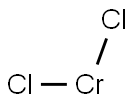-
性質
塩化クロム (II) は無色の針状結晶で、塩化クロム (III) は赤紫色の結晶です。高温で塩化クロム (IV) は、安定な気体として存在します。
HSAB則で塩化クロム (III) はルイス酸です。3価のクロムは配位子の置換反応の活性が低いですが、少量の亜鉛や塩酸などの還元剤を加えると、活性が向上します。
塩化クロム (II) に還元されて、すぐに配位子の交換反応が起き、CrCl3と塩素架橋を介した電子転移が起こり、3価のクロム錯体が得られます。活性化したCr (II) は再生可能です。Cr (III) がすべて置換されるまで反応は進みます。
-
解説
塩化クロム,無色の針状晶.融点824 ℃.水に易溶.水溶液からは六水和物,四水和物,三水和物,二水和物が得られる.無水物は乾燥した空気中では安定であるが,湿った空気中では容易に酸化される.強い還元剤である.クロムの冶金,有機反応の還元剤や触媒に用いられる.有毒.
-
構造
塩化クロム(II) は二塩化クロム、塩化クロム(III)は三塩化クロム、塩化クロム (IV) は四塩化クロムとも呼ばれます。塩化クロム (II) の化学式はCrCl2、塩化クロム (III) の化学式はCrCl3、塩化クロム(IV)の化学式はCrCl4です。
塩化クロム (II) の分子量は122.90、塩化クロム (III) の分子量は158.36、塩化クロム(IV)の分子量は193.81です。塩化クロム (III) の無水物は紫色の結晶であり、水にはほとんど溶けません。
六水和物のCrCl3・6H2Oは錯体であり、水和異性体である[Cr(H2O)6]Cl3、[Cr(H2O)5Cl]Cl2・H2O、[Cr(H2O)4Cl2]Cl・2H2Oが存在します。配位子にピリジンを用いると[CrCl3(C5H5N)3]が生成し、ほとんどのCr(III)錯体は配位数6の八面体構造を取っています。
-
合成
高温で単体を化合すると塩化クロム (III) の無水物が合成できますが、炭素の存在下で三酸化二クロムと塩素を800°Cで反応させても生成します。塩化クロム (III) の水和物は、塩酸とクロムの反応で合成可能です。650°Cで塩化クロム (III) 六水和物は四塩化炭素と反応して、無水物が得られます。塩化チオニルを用いても脱水可能です。
500°Cで水素を用いて塩化クロム (III) を還元すると、塩化クロム (II) が生成します。塩化クロム (II) は、塩化水素と酢酸クロムの反応でも合成可能です。
-
製造
二塩化クロムともいう.加熱した金属クロムと塩化水素の直接反応,または加熱した塩化クロム(Ⅲ)に水素を通じると無水物が得られる.
-
化学的特性
grey green powder
-
使用
Chromium(II) chloride is used as a precursor to other inorganic and organometallic chromium complexes. It is a reagent in the Nozaki-Hiyama-Kishi reaction. It is also used in the Takai olefination to prepare vinyl iodides from aldehydes in the presence of iodoform.
-
一般的な説明
A white crystalline solid. The primary hazard is the threat to the environment. Immediate steps must be taken to prevent its spread to the environment. CHROMIUM(II) CHLORIDE is used to make other chemicals and as an oxygen absorbent.
-
空気と水の反応
Stable in dry air, but oxidizes rapidly in moist air or standing water with liberation of Hydrogen, [Merck, 11th ed., 1989]. Soluble in water.
-
反応プロフィール
Inorganic reducing agents, such as CHROMIUM(II) CHLORIDE, react with oxidizing agents to generate heat and products that may be flammable, combustible, or otherwise reactive. Their reactions with oxidizing agents may be violent. Long storage of a CHROMIUM(II) CHLORIDE solution culminated in an explosion. This was ascribed to the slow buildup of hydrogen gas that was produced by reduction of water by the Cr(II) ion [MCA Case History No. 1660].
-
健康ハザード
DUST: Harmful if inhaled. SOLID: Irritating to skin and eyes. Harmful if swallowed.
-
使用用途
塩化クロムは、有機反応の触媒、めっき、顔料、医薬品、媒染剤などに使われます。塩化クロム (II) は、主に技術で使用可能です。
電気めっきによって、装飾用の金属上にクロムの薄層を堆積させることで、耐腐食性および表面硬度が増大します。織物媒染剤に使用する場合には、染色する布と染色剤との間でリンクとして作用します。また、塩化クロム (II) は、オレフィンや防水剤の生産のための触媒として使用可能です。
クロム (III) は耐糖能因子の一部であり、インスリンが促進する反応の活性化因子です。その効果を利用して、グルコース、タンパク質、脂質の代謝を活性化し、人間や動物のインスリン作用を促進する医薬品に使用されています。
-
職業ばく露
It is used in metal alloys and metal finishing; textile treatment including mothproofing, waterproofing, printing; and dying, leather tanning; making photographic chemicals; and green pigments for various uses.
-
概要
塩化クロムとは、の塩化物です。
塩化クロムには酸化数の異なる化合物が存在し、塩化クロム (II) 、塩化クロム (III) 、塩化クロム (IV) です。
塩化クロム (II) は、白熱した金属クロムに塩化水素を加えて得られます。塩化クロム (III) はの気流下で、金属クロムを強く熱すると生成します。塩化クロム (IV) は、塩化クロム (III) と塩素を600~700°Cに熱すると得られますが、不安定で単離は容易ではありません。
-
輸送方法
UN3260 Corrosive solid, acidic, inorganic, n.o. s., Hazard class: 8; Labels: 8-Corrosive material, Technical Name Required.
-
純化方法
It is obtained from the dihydrate by heating in vacuo at 180o. It is a very hygroscopic white powder which dissolves in H2O to give a sky blue solution. It is stable in dry air but oxidises rapidly in moist air and should be stored in air tight containers. It sublimes at 800o in a current of HCl gas and should be cooled in the presence of HCl gas. Alternatively it can be washed with air-free Et2O and dried at 110-120o. [Burg Inorg Synth III 150 1950, Balthis & Bailar (4 H2O) Inorg Synth I 125 1939, Hein & Herzog in Handbook of Preparative Inorganic Chemistry (Ed. Brauer) Academic Press Vol II pp 1336-1338 1965.]
-
不和合性
Very hygroscopic. The substance is a strong reducing agent. Reacts with oxidizers. Reacts with water, forming flammable hydrogen gas
-
参考文献
J.W. Tracy, et al., Acta Crystallogr., 14, 927 (1961), DOI: 10.1107/S0365110X61002710.

